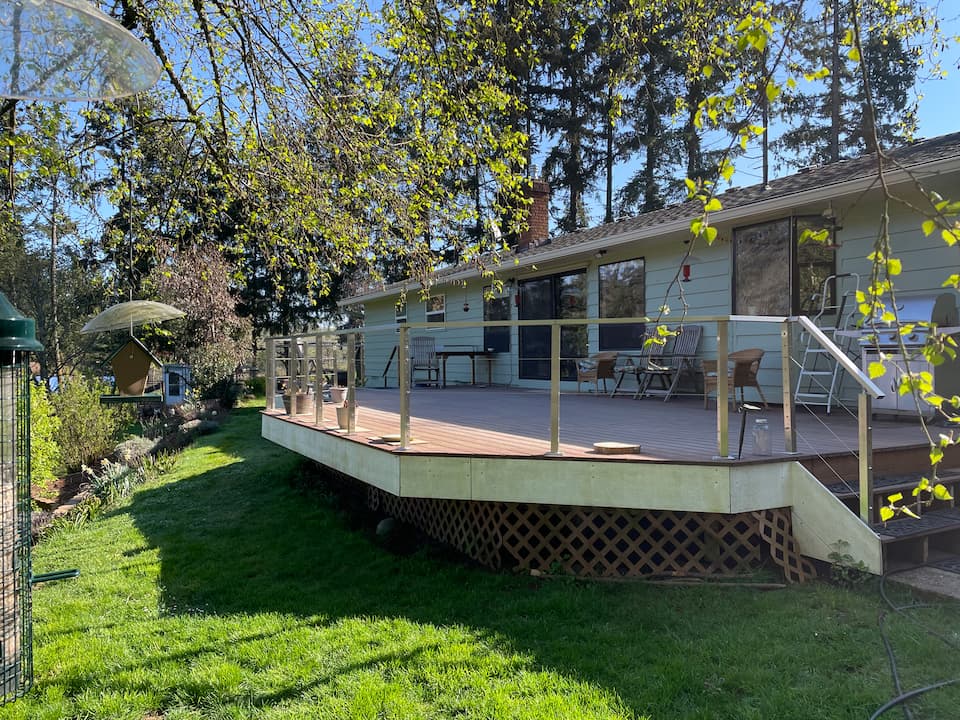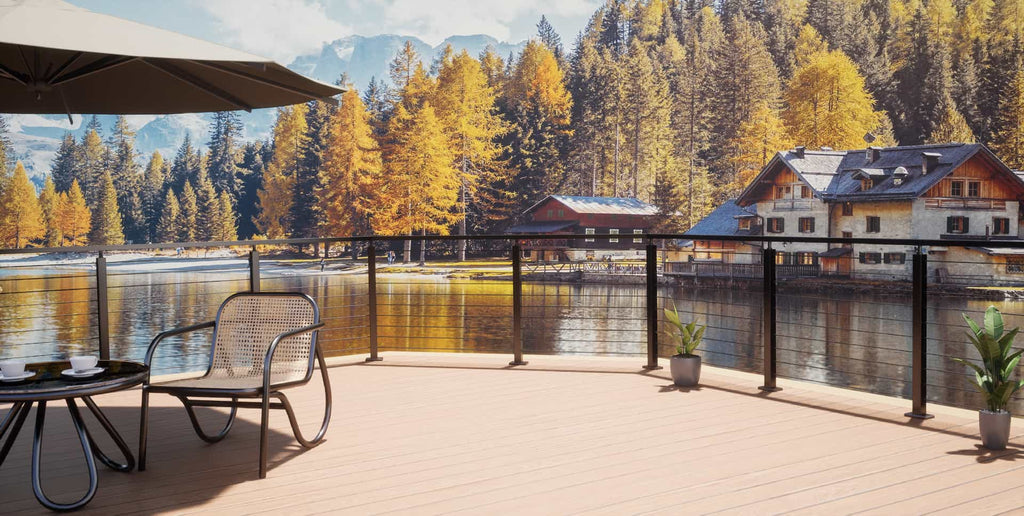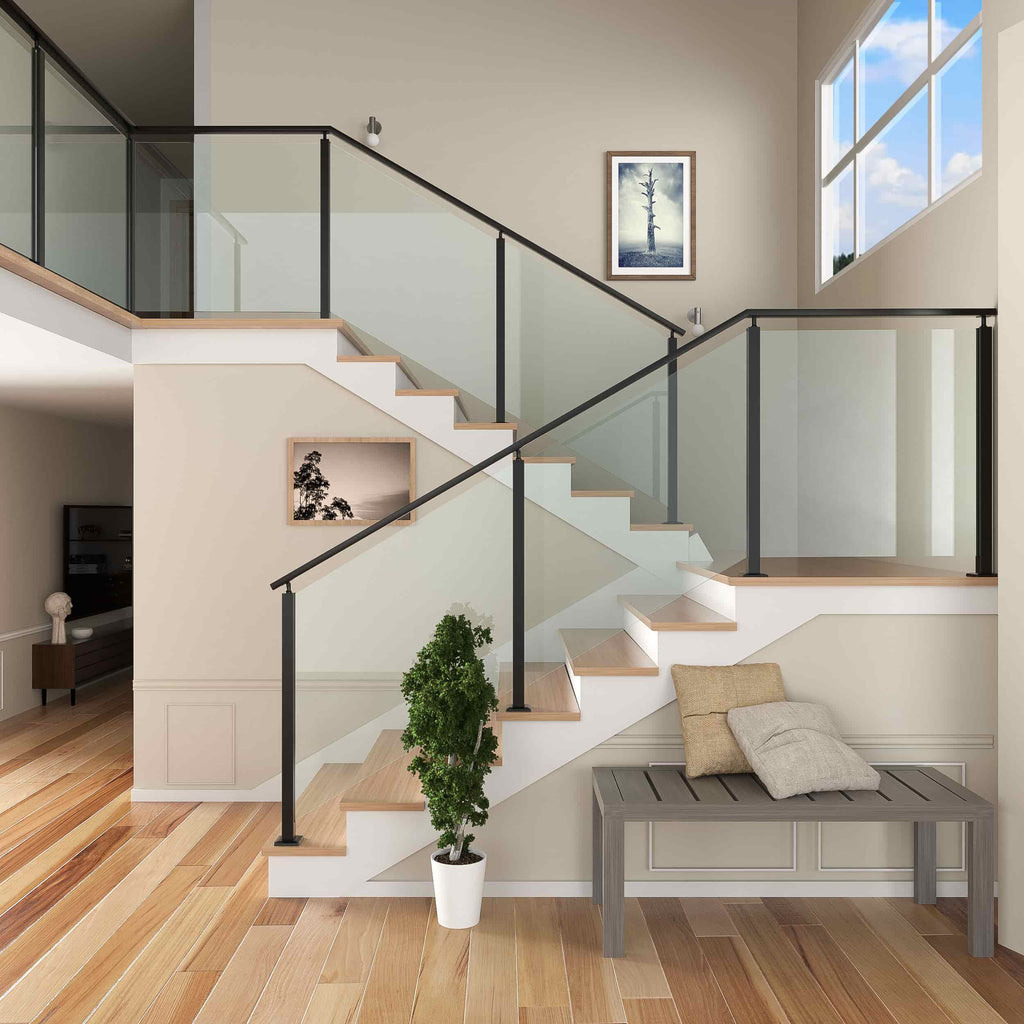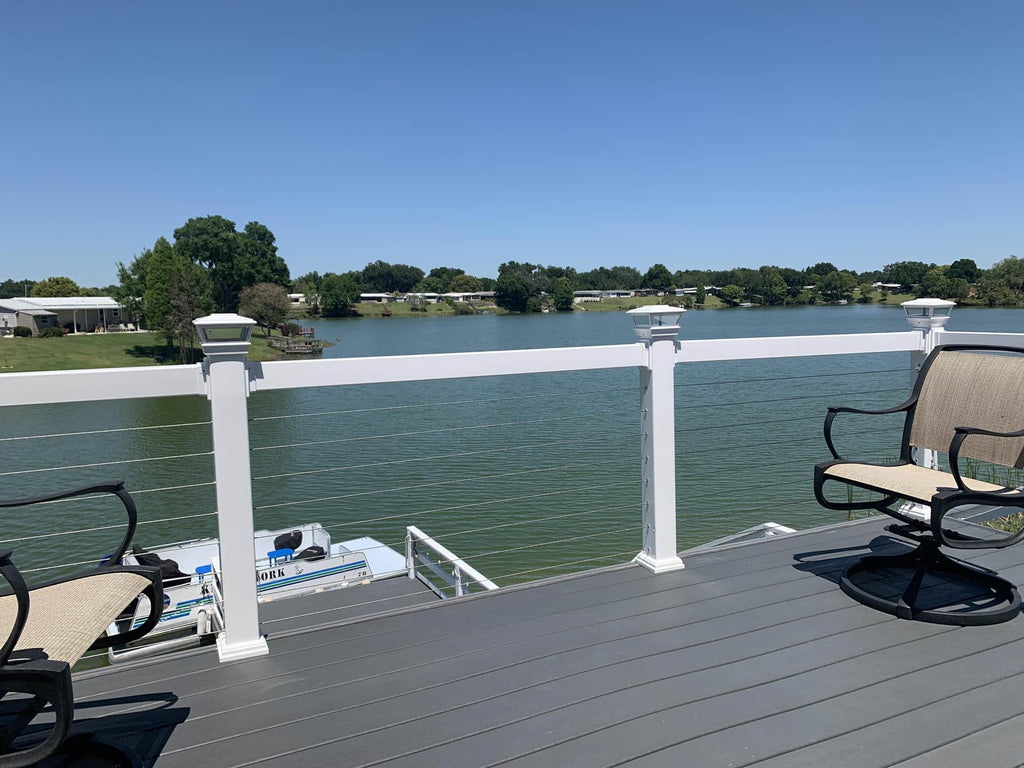TABLE OF CONTENTS
Cable vs. Glass Railings: Which is Better for Beach Houses

When you're setting up your beach house, choosing the right railings is a big deal. You want them to last against the wind and salt but also make sure you can enjoy your view of the sea. We're here to help you decide between cable and glass – they're both great choices but in different ways. Let's figure out together which one will make your beach house perfect for those relaxing days by the water.
Quick Comparison Sheet
| Factor | Cable Railings | Glass Railings |
| Aesthetic | Minimalist, industrial vibe; doesn't obstruct views | Sleek, can appear invisible; doesn't obstruct views |
| Durability | Stainless steel resists corrosion with maintenance | Tempered glass withstands impact, requires specific treatments for durability |
| Safety | Requires correct tension and regular checks | Must be tempered to avoid dangerous breakage; typically very safe |
| Maintenance | Less frequent, involves tightening and occasional cleaning | Requires regular cleaning to remain clear; more labor-intensive |
| Wind Protection | Allows more air flow; less protection from wind | Acts as a solid barrier against wind |
| Cost | Generally lower initial cost, but consider long-term maintenance | Higher initial cost due to materials and installation; consider long-term cleaning costs |
| Installation | Can be a DIY project; requires precision for tension | Professional installation is recommended due to the weight and precision needed |
| Best For | Those preferring a modern look and minimum view obstruction who don’t mind some maintenance | Those prioritizing clear views and wind protection with a willingness to commit to regular cleaning |
Beach Homes and Railings: The Essentials
Coastal Living and Your Home
Living by the beach means dealing with a few extra home-care issues. Salt from the ocean can eat away at building parts, humidity might warp or damage materials, and storms can be tough on your house. It's important to pick stuff that can handle these beach-specific problems so your home lasts longer and you don't have to fix things all the time.
Keeping It Safe
The most important job for railings is to keep people safe. This is especially true in beach homes where decks and balconies are common hangout spots. Railings need to be strong and built to certain height and strength standards, which are set by local safety rules. These rules make sure that your railings do their job well, whether it's just an average day or when the weather turns rough.
Looks and Living
Railings aren’t just there for safety; they add to how your home looks and how you use it. Glass railings are great for blocking wind without messing with your view, while cable railings have a clean, open look that lets in more breeze and doesn’t block the scenery. When picking out railings, it helps to think about how they'll match your home’s style and what you need from your living space.
Views vs. The Elements
One of the perks of having a beach house is the awesome views. When choosing railings, you want to keep as much of the view as possible while also considering how much sun and wind you want coming through. Glass keeps the view but needs cleaning to stay clear. Cable railings are easier to maintain but might not shield you from the wind as much. It's all about what matters more to you—keeping the elements out or enjoying the full beachfront experience.
Making It Last
Choosing materials that last a long time and are easy to take care of is smart, especially in a beach environment that can be tough on your house. Stainless steel, aluminum that's been treated with a special powder to protect it, and toughened glass are good choices because they stand up well to the seaside climate. Even if some options cost more upfront, their ability to last without needing lots of maintenance could save you money down the road.
Cable Railings: An Overview of Features, Pros, and Cons

Cable railings are a modern, stylish alternative to traditional railing systems, characterized by their use of horizontal or vertical cables—usually made from durable stainless steel—in lieu of spindles or glass. This design choice not only adds a sleek, contemporary look but also boasts practical benefits like rust resistance and strength.
Key Features:
- Aesthetic Appeal: Cable railings offer a minimalist, industrial vibe that's particularly well-suited to contemporary homes.
- Unobstructed Views: The slender profile of the cables ensures a clear line of sight, an asset for properties with scenic vistas.
- Material Durability: Stainless steel cables resist corrosion, an essential feature for coastal buildings exposed to salty air.
Installation is a critical aspect that requires careful planning. Posts must be anchored securely at precise intervals to maintain cable tension, a necessity for the safety and structural integrity of the system. While complex, a proper setup ensures compliance with building codes and prolongs the lifespan of the railing.
Pros:
- Enhanced Views: Maximizing visibility, cable railings practically disappear from sight, making them ideal for viewing landscapes or seascapes.
- Modern Design: They align seamlessly with modern architectural styles, bringing a clean, updated look to any home.
- Longevity: With appropriate care, including regular inspections and cleanings, these railings can endure harsh environments for years.
Cons:
- Maintenance Requirements: The need for occasional tightening and cleaning to prevent corrosion means they're not entirely maintenance-free.
- Safety Inspections: Regular adjustments may be needed to ensure the spacing between cables meets safety standards.
- Wind Exposure: Unlike solid barriers, cables do little to block winds, which could be an issue in areas with frequent strong gusts.
Glass Railings: Defining Characteristics, Pros, and Cons

Glass railings are a popular architectural feature in modern beach homes, serving both as a functional barrier and a design element that complements the aesthetics of a living space. These barriers use glass panels—commonly tempered for resilience—as their core material, which can be framed with metal or wood or presented in a frameless design to achieve a more seamless look.
Main Features:
- Aesthetic Versatility: Glass railings can adapt to various styles, enhancing everything from cutting-edge modern designs to classic traditional homes.
- Safety with Style: The tempered glass provides a sturdy and safe barrier while maintaining an elegant appearance.
- Variety of Glass Options: Homeowners can choose from clear, tinted, frosted, or patterned glass to suit their privacy needs and design preferences.
Installation of glass railings is precise work, involving meticulous site preparation, exact measurements, secure frame installation, and careful placement of the glass panels to comply with safety standards.
Pros:
- Uninterrupted Views: Perfect for homes by the sea, glass railings create an unbroken visual connection with the oceanic surroundings.
- Protection from Winds: Acting as a transparent windbreak, these railings enable comfortable enjoyment of outdoor spaces even on breezy days.
- Adjustable Privacy Levels: By selecting different types of glass, homeowners can enjoy privacy without sacrificing daylight.
Cons:
- Demanding Maintenance: To keep them looking pristine, glass railings require frequent cleaning to remove sea spray marks, smudges, and fingerprints.
- Hefty Weight: The substantial weight of glass panels calls for professional installation and robust support structures.
- Higher Costs: When compared to cable railings, glass systems are generally more expensive due to the higher costs of materials and the complexity of installation.
Comparative Analysis: Cable vs. Glass Railings

Aesthetics - Impact on Visual Appeal
When it comes to aesthetics, cable railings offer a modern, minimalist look that can blend seamlessly with different architectural styles without obstructing views. Glass railings also provide an unobstructed view, but with a different approach, offering a smooth surface that can reflect the surroundings and sometimes appear almost invisible.
Durability - Endurance Against the Harsh Coastal Environment
Both cable and glass railings can be durable options for beach houses when made from high-quality materials. Stainless steel cables are resistant to corrosion, particularly if they are properly maintained, while tempered glass is strong enough to withstand heavy impacts and environmental stress. However, both may require specific treatments to extend their lifespan in coastal conditions.
Safety - Compliance with Codes and Regulations
Safety is paramount for any railing system. Cable railings must be tensioned correctly and checked regularly to prevent sagging that could pose a safety risk. Glass railings are typically very safe due to their solid panels, but they need to be made of tempered glass to ensure they don't break into dangerous shards upon impact.
Maintenance - Comparison of Ongoing Care and Longevity
Cable railings generally require less intensive daily maintenance but may need more frequent checks and adjustments to maintain the correct tension. On the other hand, glass railings need regular cleaning to remain spotless and clear, which can be more labor-intensive overall.
Privacy and Environmental Considerations
For privacy concerns, glass wins out as it can be frosted or tinted. Cable railings do not offer intrinsic privacy but can impact the environment less visibly, preserving the natural aesthetic. In terms of wind protection, glass provides a solid barrier, whereas cables allow more air passage, which can be a disadvantage on particularly breezy days.
Cost Implications
Initial costs for glass railings are generally higher than for cable railings, mainly due to material and installation factors. However, the long-term cost should also consider the maintenance required over the years, which can add up for glass railings due to the need for frequent cleaning.
Installation Challenges
Installing cable railings requires precision to ensure proper tension, but they can often be a DIY project for skilled homeowners. Glass railings almost always require professional installation due to the weight and handling care of the glass panels, as well as the need for precise fixtures to safely secure them.
Each system has its own set of benefits and challenges, and the final choice will depend on personal preference, lifestyle, and the specific demands of the property's location. The next section will wrap up the discussion, summarizing key points to aid in making a well-informed decision about the best railing system for a beach house.
Final Thoughts
When it's time to choose a railing for your beach house, think about what matters most to you. If you love a clean, modern look and don't mind giving the cables a tighten now and then, cable railings could be your pick. They keep those views wide open and let the breeze through. But if you're all about that crystal-clear outlook and want to keep the wind at bay, glass railings might be the way to go—even if they need a good wipe-down more often. Remember, investing a bit more at the start on a glass setup could save you hassle down the line. And while installing cable railings can be a savvy DIY project, you'll likely need some pros to put in those glass panels safely. Whatever you choose, make sure it's something that’ll make your beachside living secure, easy on the eyes, and enjoyable for all your sunny days ahead.




